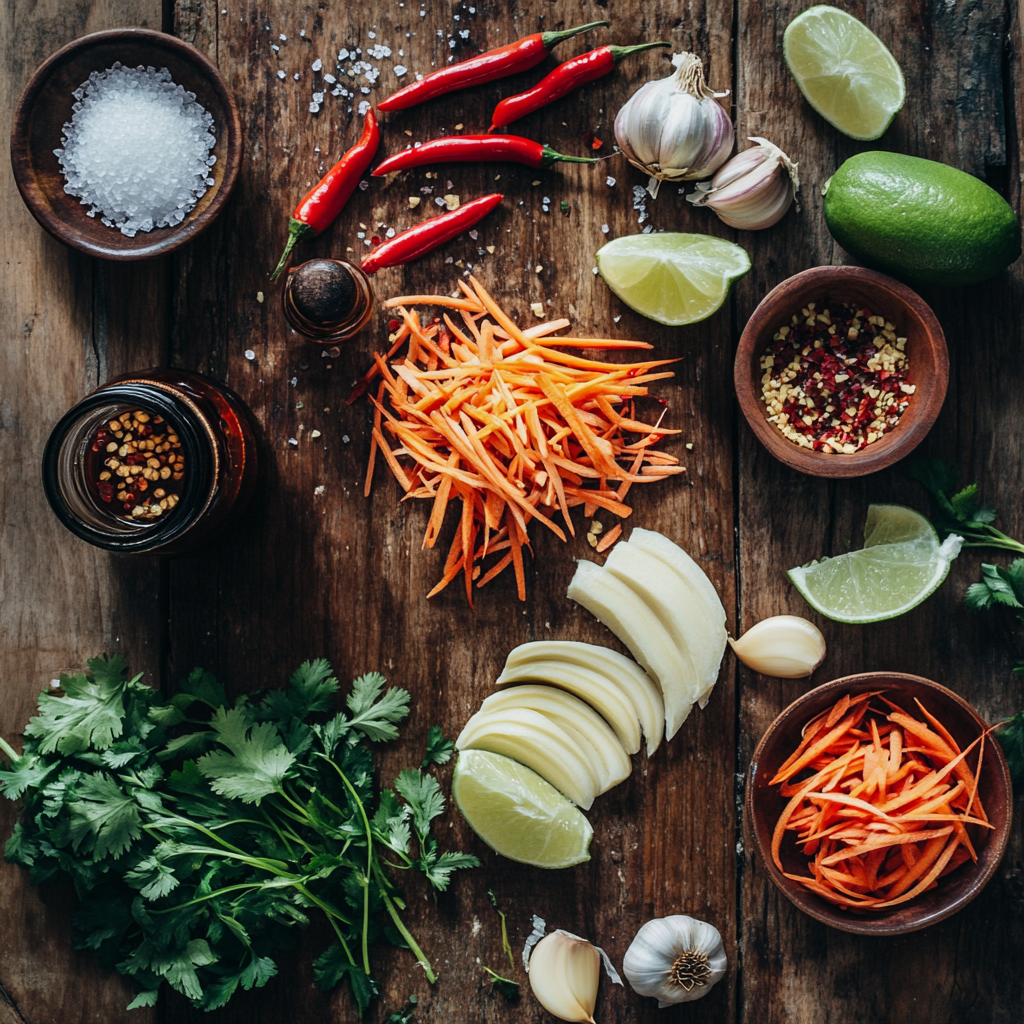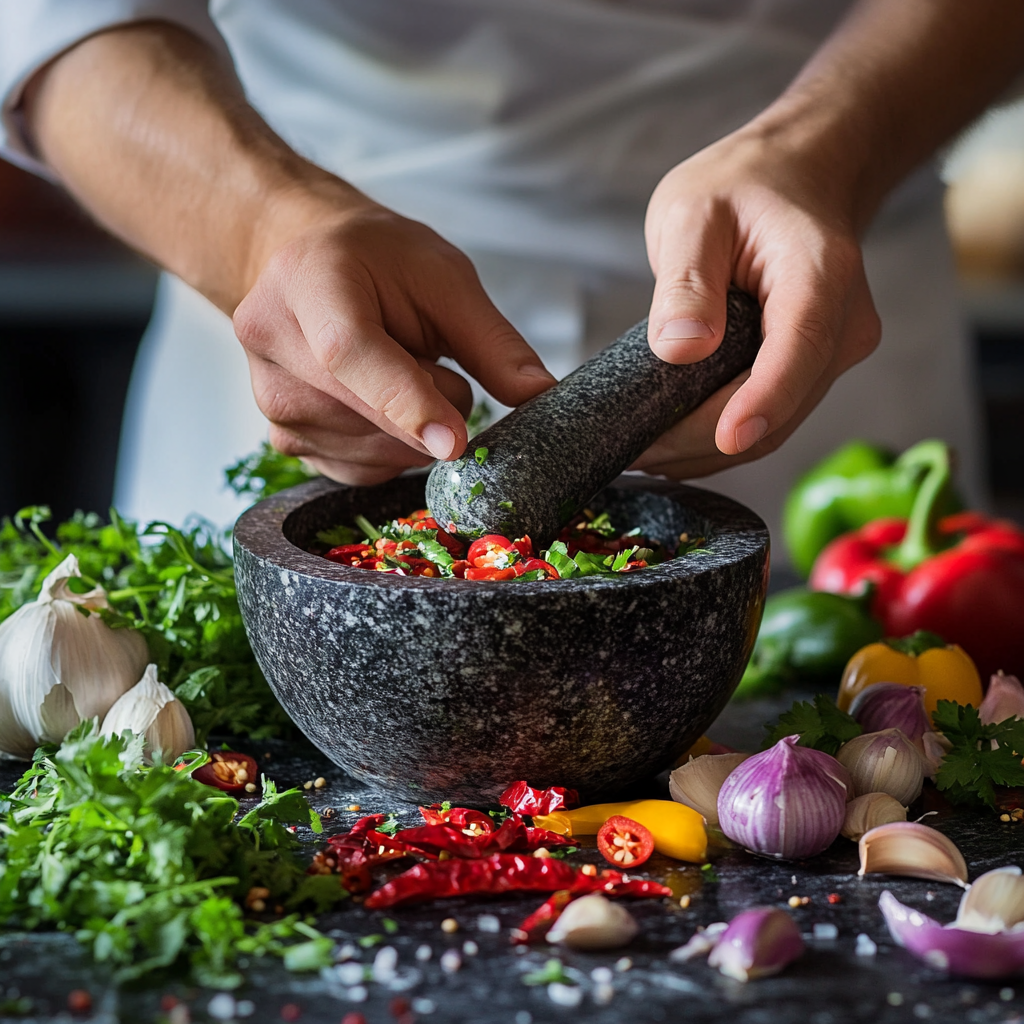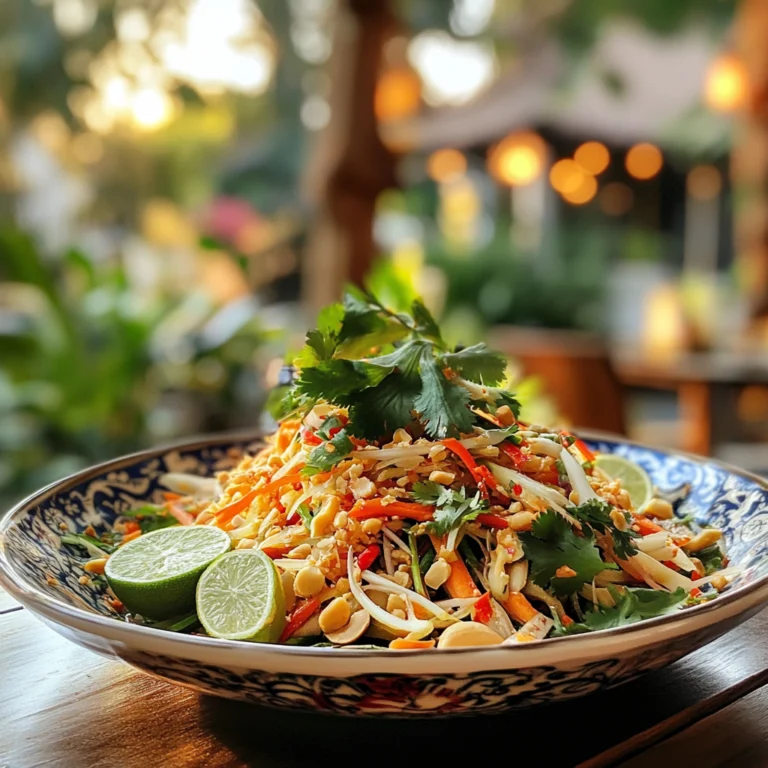Northeastern Salad: A Flavorful Adventure
Northeastern Salad, also called Som Tum in Thai food, is a mix of bright flavors and interesting textures. This dish includes crunchy vegetables, strong spices, and sour dressings, making it a standout meal. Coming from the Isaan area of Thailand, it holds cultural importance while delighting taste buds worldwide. In this guide, we’ll explore everything about Northeastern Salad—from its ingredients and preparation to its health benefits and serving tips.
Table of contents
Introduction to Northeastern Salad
The charm of Northeastern Salad lies in its simplicity and flexibility. Moreover, this refreshing dish shows the essence of Thai food, blending spicy, sweet, sour, and salty flavors into a smooth mix. Consequently, with origins deeply rooted in Thailand’s Isaan area, Northeastern Salad has spread across borders to become a global favorite.
What is Northeastern Salad?
Northeastern Salad is a traditional Thai dish that features shredded green papaya as the main ingredient. What’s more, its uniqueness lies in its ability to change to different tastes. For example, you can try versions that include cucumber, carrots, or even unripe mango, depending on your preference. Indeed, this ability to adapt keeps the dish exciting.
The recipe mixes fresh vegetables with strong seasonings such as fish sauce, lime juice, and chilies. This creates a mix of flavors that’s not just a treat for the taste buds but also a celebration of Thai cooking skills.
Origins and Cultural Significance
The dish comes from Thailand’s northeastern area, where it is a regular part of the local diet. Furthermore, known as Isaan food, this type of cooking is famous for its strong flavors and low use of fats. In fact, in Isaan culture, food isn’t just daily nourishment—it’s a way of life. For example, Som Tum reflects this belief, often served during family get-togethers or community celebrations.
Moreover, Northeastern Salad has also become a symbol of Thai street food culture, offering a taste of authenticity to anyone who tries it. Additionally, its preparation, often done with a mortar and pestle, adds a tactile connection to its heritage, emphasizing fresh ingredients and hands-on techniques.
Ingredients of Northeastern Salad
Key Ingredients of Northeastern Salad
The magic of Northeastern Salad lies in its carefully chosen ingredients. Indeed, each part plays a key role in creating the dish’s iconic flavor profile. Moreover, from fresh produce to tangy dressings, every part has a specific job, making sure the salad achieves the perfect balance of spicy, sour, salty, and sweet. Ultimately, the freshness of the ingredients, mixed with bold flavors, turns a simple dish into a culinary masterpiece.
This salad’s flexibility is another reason for its popularity. You can adjust the ingredients to suit your taste while staying true to its traditional essence. Now, let’s break it down into its basics.
Main Components
The heart of Northeastern Salad lies in its fresh, crunchy base. Additionally, the supporting cast of bold flavors ensures it remains a sensory delight. For example, the main parts include:
Green Papaya
Green papaya is the soul of this salad. Its firm texture and mildly tangy flavor make it a perfect base for the dish. When sliced, it provides the signature crunch that sets apart Northeastern Salad from others. It’s not just delicious but also rich in nutrients like C and A.
Chilies
Chilies give the salad its fiery kick, which shows the importance of Isaan cooking. Specifically, cooks often choose bird’s eye chilies for their intense heat and vibrant red hue. However, you can adjust the heat to suit your palate, making sure the dish stays both easy to change and real to its roots.
Flavor Enhancers
While the base ingredients provide texture and freshness, the flavor enhancers bring the dish to life. These ingredients infuse the salad with depth and complexity.
Fish Sauce
Fish sauce is a cornerstone of Thai cooking, and its salty umami flavor is essential in Northeastern Salad. Made from fermented fish, this liquid seasoning complements the dish’s tangy and spicy notes, creating an irresistible balance.
Lime Juice
Freshly squeezed lime juice adds a zesty tang, enhancing the salad’s overall brightness. This ingredient doesn’t just boost the flavor but also ties together all the other components. Its acidity contrasts beautifully with the spiciness of the chilies and the richness of the fish sauce.

Preparation Methods
How to Prepare Northeastern Salad
Making Northeastern Salad is as much about the process as it is about the ingredients. Whether you’re sticking to tradition or trying new ideas, the steps are simple yet life-changing. The preparation blends vibrant ingredients into a mix of flavors while keeping the dish’s fresh texture. All you need is a little patience and a mortar and pestle to bring this famous salad to life.
Traditional Preparation Techniques
Traditionally, cooks make Northeastern Salad using a mortar and pestle, tools that easily mix the flavors. They start by gently crushing chilies and garlic to release their strong smells. Next, they add shredded green papaya along with other ingredients like tomatoes, long beans, and peanuts. The key is to avoid over-crushing; instead, the goal is to lightly press the pieces so they absorb the seasoning without losing their crunch.
Cooks then mix in seasonings like fish sauce, lime juice, and palm sugar to create a perfectly balanced sauce. They toss this mix with the papaya, making sure every strand is covered in bold and zesty flavor. The result? A dish that’s both tasty and beautiful to look at.

Modern Variations and Adaptations
While tradition remains strong, modern adaptations of Northeastern Salad cater to diverse preferences. Some variations substitute green papaya with unripe mango, cucumber, or even carrots, adding unique twists to the classic dish. Vegetarians often swap fish sauce for soy sauce and include roasted tofu as a protein-rich addition.
Blending different cuisines is also a growing trend. You’ll find fusion versions featuring ingredients like avocado or quinoa for a contemporary take. Regardless of the adaptation, the heart of the salad—its fresh, vibrant flavor—remains unchanged.
Nutritional Benefits
Health Benefits of Northeastern Salad
Som Tum isn’t just delicious—it’s also a powerhouse of nutrients. With its low-calorie, high-fiber profile, it’s a guilt-free indulgence for anyone seeking a healthy yet satisfying meal. The combination of fresh vegetables and nutrient-packed dressings makes it a superfood in its own right.
Rich in Vitamins and Minerals
The ingredients in Northeastern Salad are packed with essential vitamins and minerals. Green papaya, for instance, is rich in vitamin C, which supports a strong immune system, and vitamin A, promoting good vision and healthy skin. The peanuts contribute protein and healthy fats, while lime juice offers a generous dose of antioxidants.
Low in Calories
If you’re watching your waistline, Som Tum is an excellent choice. Moreover, its low-calorie content, combined with its high fiber levels, makes it ideal for those aiming to maintain or lose weight. Additionally, its spicy kick can help boost metabolism, which further adds to its health benefits. As a result, this dish offers both great taste and nutritional advantages.
Nutritional Information
Here’s the approximate nutritional breakdown for Northeastern Salad per 100 grams:
| Nutrient | Amount (per 100g) |
|---|---|
| Calories | 70 kcal |
| Protein | 2 g |
| Fat | 3 g |
| Carbohydrates | 10 g |
| Fiber | 2 g |
| Sodium | 250 mg |
| Vitamin C | 25 mg |
Serving Suggestions
Serving Northeastern Salad
Som Tum, or Northeastern Salad, delights not only the taste buds but also the eyes when chefs present it thoughtfully. Thoughtful presentation and pairing elevate the dining experience, transforming it into a showstopper on any table. Whether you serve it as a light appetizer or a main course, this salad shines when you give it the attention it deserves.
To stay true to its roots, serve it fresh—right after preparation. This ensures that the textures remain crisp and the flavors stay vibrant. For authenticity, use a traditional Thai ceramic or bamboo plate, which adds an extra layer of cultural charm to your presentation. Don’t forget to garnish with roasted peanuts or fresh cilantro for a pop of color and flavor.
Accompaniments and Pairings
Northeastern Salad is highly versatile and pairs beautifully with other dishes. For a complete meal, serve it alongside sticky rice or grilled chicken. If you’re aiming for a vegetarian spread, steamed rice noodles or crispy tofu make excellent companions. The spicy, tangy flavors of the salad also complement mild soups or stir-fried vegetables, creating a balanced and fulfilling menu.
Presentation Tips
Presentation plays a crucial role in enhancing the appeal of Northeastern Salad. Arrange the shredded papaya in a neat pile at the center of the plate, with colorful elements like tomatoes and chilies scattered artfully. Add a wedge of lime on the side for an extra splash of color and a squeeze of freshness. Using a drizzle of dressing over the top and sprinkling crushed peanuts last ensures that every detail stands out. With these simple tips, your salad will look as appetizing as it tastes.
Frequently Asked Questions
FAQs about Northeastern Salad
Northeastern Salad is a globally loved dish, but questions about its origins, ingredients, and preparation often arise. Whether you’re a first-time cook or a longtime fan, these FAQs aim to clear up common doubts and provide useful tips to make your Som Tum experience even better.
What is the origin of Northeastern Salad?
Northeastern Salad originates from the Isaan region of Thailand, a northeastern area known for its bold, flavorful cuisine. This dish reflects the region’s resourcefulness, relying on fresh, local ingredients to create a meal that’s both delicious and nutritious. It has since become a symbol of Thai culinary tradition worldwide.
Can I substitute green papaya with other fruits?
Yes, green papaya can be substituted with fruits like unripe mango, cucumber, or even zucchini for a similar texture. These alternatives retain the dish’s crunch and freshness while adding their unique flavor twists, making them excellent substitutes when papaya isn’t available.
Is Northeastern Salad spicy?
Northeastern Salad is traditionally spicy, thanks to the use of bird’s eye chilies. However, the heat level can easily be adjusted by adding fewer chilies or using milder varieties. This flexibility makes it suitable for those who prefer a milder flavor while maintaining its authentic taste.
How can I make a vegetarian version of Northeastern Salad?
To make a vegetarian version, substitute fish sauce with soy sauce or a plant-based fish sauce alternative. You can also add tofu or tempeh for extra protein, keeping the dish wholesome and satisfying without compromising its traditional flavors.
What dishes pair well with Northeastern Salad?
Northeastern Salad pairs wonderfully with sticky rice, grilled chicken, or steamed fish. For vegetarian meals, it complements dishes like rice noodles, fried tofu, or stir-fried vegetables. The salad’s vibrant flavors provide a perfect contrast to these mild accompaniments.
How should I store leftover Northeastern Salad?
To store leftovers, place the salad in an airtight container and refrigerate it. It’s best consumed within a day to retain its crunch and flavor. Avoid freezing, as this can alter the texture and diminish the freshness of the ingredients.
Conclusion
Northeastern Salad is more than just a dish; it’s a celebration of Thai culture, tradition, and the art of balancing flavors. With its bold combination of tangy, spicy, and savory notes, this salad offers a sensory experience that lingers long after the meal is over. Whether you’re enjoying it as part of a hearty meal or a light snack, its versatility and health benefits make it a favorite for all occasions.
Exploring the origins, ingredients, and preparation of Som Tum allows you to connect with the culinary traditions of Thailand. By trying it yourself, you embrace not only its unique taste but also its cultural significance.
Embracing the Flavors of Northeastern Salad
Every bite of Northeastern Salad tells a story of authenticity and freshness. The crunch of green papaya, the zing of lime, and the heat of chilies come together in perfect harmony. This dish is a testament to how simple ingredients, when combined thoughtfully, can create something extraordinary. It invites you to experience the essence of Thai street food and Isaan culinary traditions.
Encouragement to Try Making It at Home
Don’t let the simplicity of this dish fool you—making Northeastern Salad is an adventure worth embarking on. Whether you’re sticking to the traditional recipe or adding your modern twist, preparing it at home is easy and rewarding. Start with fresh ingredients, follow the steps, and adjust the flavors to your liking. With a bit of practice, you’ll soon master this vibrant dish and impress everyone at your table!
What is Abacha salad made of?
Abacha salad, also called African salad, is a traditional Nigerian dish made from dried and shredded cassava that is soaked in water to soften before use. The cassava forms the base of the salad, and it’s mixed with ingredients like palm oil, ugba (which are fermented African oil bean seeds), onions, and ground crayfish. Additional seasonings such as ground pepper and salt are added for flavor. Sometimes, optional ingredients like garden eggs, garden egg leaves, fried fish, or kpomo (cow skin) are included to enhance the taste and texture.
What is Farro salad made of?
Farro salad is a flavorful dish centered around farro, an ancient grain known for its nutty flavor and chewy texture. This grain is usually cooked and combined with ingredients like cherry tomatoes, cucumbers or celery, feta cheese, and chickpeas. Fresh herbs like parsley or basil are commonly added for a burst of freshness. The salad is typically dressed with a light vinaigrette made from olive oil, lemon juice, or red wine vinegar, creating a vibrant and hearty meal.
Why is it called Israeli salad?
The dish known as Israeli salad gets its name due to its association with Israel, where it is a staple of the national cuisine. It is made from finely diced tomatoes, cucumbers, and onions, dressed simply with olive oil and lemon juice. While similar salads are common throughout the Middle East, this particular version became internationally known as “Israeli salad” due to its popularity and frequent serving in Israeli households and restaurants. The name reflects its local identity, even though its origins are shared with neighboring cuisines.

